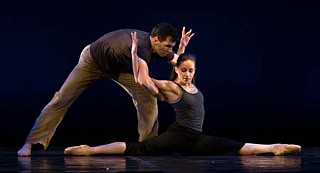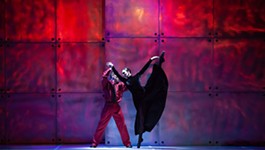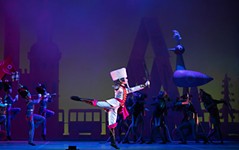'silence within silence'
Going in deep with E.E. Cummings
By Jonelle Seitz, Fri., March 25, 2011
What inspires a non-narrative dance? Most often, the seeds of choreography are the music and the movement itself: the body's capability to react to music through movement serves as muse. For the 2007 work silence within silence, which Ballet Austin is reviving as part of this year's Studio Theater Project, Artistic Director Stephen Mills used love poems by E.E. Cummings – some of which are about the body's capabilities in intimacy – as inspiration. Set to piano music by Brahms, the ballet is composed of four male-female duets, each characterized by a distinct mood imparted by a Cummings poem.
Dance and poetry have several parallels: Being somehow more than the sum of their parts, they are hard to define in prose and rely heavily on context. Mood is important – so important that it has a tangible quality, an in-hand feeling. Consider, for example, the mood evoked by these lines from "i like my body when it is with your," one of silence's source poems:
... i like kissing this and that of you,
i like, slowly stroking the, shocking fuzz
of your electric fur ...
Michelle Thompson first encountered these lines during the ballet's creation, when Mills bestowed the poem on her and partner Jim Stein. Before each performance in 2007, Thompson read the poem to be reminded of its mood and allow it to influence her quality of movement. "When I read the poem, I get a tactile sensuality," she says, rubbing her fingers together as if testing the fineness of a fabric. But this close reading was a preference, not a requirement. Mills gave the four couples in the ballet their poems after they had already been workshopping movement sequences for several weeks. He cautioned them not to look to the poem for backstory or narrative. Thompson remembers him saying, "It's a source material."
This year, Thompson, who is in her eighth season with the company, will dance the role again, marking her return from maternity leave. Because it's the first part that Mills choreographed for her, Thompson has a special relationship with the role: "I was planning on coming back anyway, but when [Mills] announced we were doing silence within silence, I was like, 'I have to come back!'" This time, Thompson will dance with Edward Carr. (Stein has since retired.) Two of the other pairs in the ballet, Ashley Lynn Gilfix and Frank Shott, and Beth Terwilleger and Paul Michael Bloodgood, also danced in the premiere. The fourth duet, created for the now-retired pair Gina Patterson and Eric Midgely, will be danced by Aara Krumpe and Orlando Julius Canova.
Of the four duets, "i like my body when it is with your" is perhaps the most explicitly sensual. The poem's eroticism is translated into the steps by Mills – "There are lots of times when we're over each other, on each other, or I'm between his legs," Thompson says – but making those steps seem organic is up to the dancers. To avoid overt sexuality or the feeling that the steps are just "put on," the dancers have to create something of a real connection. Thompson notes that she looks out toward the audience rarely during the duet, because she and Carr stay intensely absorbed in each other. The partnership is also quite physical – Thompson clenches her fists and wrests her arms, as if struggling, to illustrate. Above all, willingness to dive in, it seems, is key. "When things get heated," explains Thompson, "you can back away or you can go deep."
In 2007, silence premiered at the Paramount, but the intimate AustinVentures StudioTheater, where no matter where you sit you can hear the dancers breathe and see their faces and sweat, is likely to add interesting tension. Sadly, though, instead of the live accompaniment by Anton Nel at the premiere, the Brahms this time will be recorded.
The Studio Theater Project runs March 25-April 3, Thursday, 7pm; Friday-Saturday, 8pm; Sunday, 3pm, at the AustinVentures StudioTheater, 501 W. Third. For more information, call 476-2163 or visit www.balletaustin.org.











